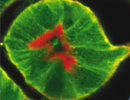Beck Group
Cell of the renal inner medulla and their adaptation to their environment
 The cells of the renal inner medulla have to cope with harsh conditions, specifically high extracellular NaCl and urea concentrations, and low oxygen tensions. They may also be confronted with pathogenic bacteria from ascending urinary tract infections. Our research focuses on the molecular mechanisms that allow these cells to survive in this potentially hostile environment. We investigate the response of renal epithelial cells to high extracellular solute concentrations in vivo and in culture, and focus on the signal transduction pathways leading to osmotic adaptation. PD Dr. Neuhofer in our group focuses in particular on the role of the osmosensitive transcription factor NFAT5 in this adaptation process, as well as in pro-inflammatory cytokine production.
The cells of the renal inner medulla have to cope with harsh conditions, specifically high extracellular NaCl and urea concentrations, and low oxygen tensions. They may also be confronted with pathogenic bacteria from ascending urinary tract infections. Our research focuses on the molecular mechanisms that allow these cells to survive in this potentially hostile environment. We investigate the response of renal epithelial cells to high extracellular solute concentrations in vivo and in culture, and focus on the signal transduction pathways leading to osmotic adaptation. PD Dr. Neuhofer in our group focuses in particular on the role of the osmosensitive transcription factor NFAT5 in this adaptation process, as well as in pro-inflammatory cytokine production.
The role of Prostanoids in medullary cell adaptation
We found that prostanoids, specifically prostaglandin E2, play a crucial role in the adaptation of medullary cells to high extracellular solute concentrations as well as to low ambient oxygen tensions. Dr. Küper in our group focuses on the signal transduction pathways regulating the production of prostglandin E2 via changes in the expression and activity of COX-2. We employ the whole spectrum of molecular biological and biochemical techniques. To estimate the osmotic contribution of intracellular inorganic electrolytes to total cell solute concentrations and to study transmembrane electrolyte gradients in general, Na+-, K+- and Cl--concentrations are determined by electron microprobe analysis, a method fostered particularly by the head of group Professor Dr. Franz-Xaver Beck.

